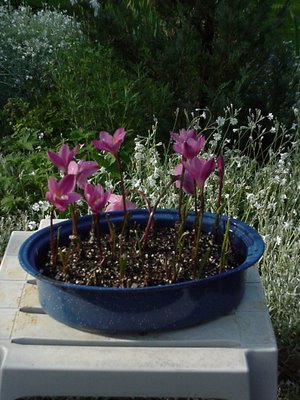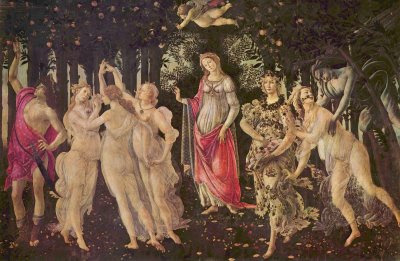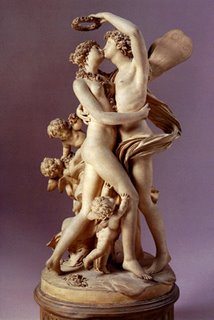
This old blue enamel roasting pan is planted with Zephyr Lilies. Going on three years now, all they ask is to be brought into frost free storage for dormancy in the winter. I got the idea for the roasting pan from some book about old fashioned plants, but someone else will have to remind me of the source, as it has slipped my mind. They are also called Fairy Lilies, or Summer Crocuses, and incidentally, the leaves will appear after the flowers.
They seem to bloom off and on all summer, most often after a good soaking. I haven't even felt bad about not repotting them, they 'll get that attention if they begin to flag. Or, I'll replace them...they are cheap and plentiful in the common rack-packages at Meijers.

Anyway, my Zephyr lilies bloomed today, so I Googled 'Zephyr' for us all.
Zephyr, as you will remember from my Floralia story about Flora, was the Roman god of the gentle west wind who brought spring. You'll notice in a lot of the portrayals of Zephyr, he is shown with insect-type wings. That may be the fairy connection with Zephyr.
I can't copy this Victorian Rococo picture of "The Triumph of Zephyr and Flora" so you'll have to click on the link to see it: but do, it's sweet.
Anyway, my reading on Wikipedia led me to an Italian Renaissance painting called Sandro Botticelli's 'The Primavera' (1482), which means The Arrival of Spring. (In case you don't know, you can click on the photo to see it in its full size.)

You'll notice it is along the lines of the birth of Venus picture in the Floralia story, and the story procedes along with the art...
One source for this scene is Ovid's Fasti, a poetic calendar describing Roman festivals.
For the month of May, Flora tells how she was once the nymph Chloris, and breathes out flowers as she does so.
Aroused to a fiery passion by her beauty, Zephyr, the god of the wind, follows her and forcefully takes her as his wife. Regretting his violence, he transforms her into Flora, his gift gives her a beautiful garden in which eternal spring reigns.
Botticelli is depicting two separate moments in Ovid's narrative, the erotic pursuit of Chloris by Zephyr and her subsequent transformation into Flora. This is why the clothes of the two women, who also do not appear to notice each other, are being blown in different directions.
Flora is standing next to Venus and scattering roses, the flowers of the goddess of love. In his philosophical didactic poem De Rerum Natura the classical writer Lucretius celebrated both goddesses in a single spring scene. As the passage also contains other figures in Botticelli's group, it is probably one of the main sources for the painting.
"Spring-time and Venus come,
And Venus' boy, the winged harbinger, steps on before,
And hard on Zephyr's foot-prints Mother Flora,
Sprinkling the ways before them, filleth all
With colours and with odours excellent."
The statue of Flora and Zephyr is by a French Rococo Victorian artist, Clodion.

No comments:
Post a Comment